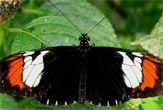
Researchers have created a hybrid butterfly whose genes and color are blends of two other species.
New species typically arise from the branching of one species into two, but in the July 15 issue of the journal Nature, scientists report the first clear evidence that evolution in animals can work the other way around, too.
Hybridization is well known among plants, but scientists had thought it was rare in animals.
Wild implications
The hybrid lab butterfly was created by interbreeding two butterflies with different colored wing markings. H. cydno has black wings with white and yellow markings, while H. melpomene has black wings with red, yellow and orange markings. The lab hybrid had black wings with red and yellow markings.
H. cydno and H. melpomene can be found near each other in the wilds of Mexico and northern South America. Where the habitats of these two butterflies overlap, a third butterfly, called H. heurippa, is found. Interestingly, the color markings on the wing of H. heurippa are nearly identical to those of the lab-made hybrid.
The study supports a long-held suspicion among biologists that H. heurippa is a wild hybrid. The researchers believe it was created naturally from the interbreeding of the same two butterfly species used to create the lab hybrid.
Sign up for the Live Science daily newsletter now
Get the world’s most fascinating discoveries delivered straight to your inbox.
"What we have done is to recreate the first steps in the evolution of H. heurippa," said study team member Jesus Mavarez from the Smithsonian Tropical Research Institute in Panama.
Take the mule, for example
The handful of known hybrid animals have lower "fitness" than their parents. In biology, fitness is a measure of an organism's ability to reproduce and thrive. For example, mules, which are the offspring of donkeys and horses, are usually sterile.
Indeed, in the current experiment, females in the first generation of hybrids were sterile (males were not). It's thought that in the wild, virile H. heurippa males bred with females of one of the parent species until eventually, non-sterile female hybrids were born. This process is called "backcrossing."
Another obstacle scientists have thought would be difficult for hybrid species to overcome: Because hybrid animal offspring inhabit the same environments as their parent species, they wouldn't be reproductively isolated enough to form a distinct species.
Scientists reported genetic evidence last year, for example, that a naturally occurring fruit fly was a hybrid, but that species preferred a different type of fruit than both its parent species. This helped to keep the species separate.
But in the new study, researchers found that H. heurippa butterflies show a strong mating preference to members of their own species rather than with their parent species.
"If you cover the red or the yellow stripe of a bi-colored hybrid female, hybrid males no longer find her the least bit attractive," Mavarez explained.
In the wild, this sexual preference would be just as effective as physical reproductive isolation.
- Image Galleries: Amazing Nature
- The Secret of Bright Butterfly Wings: LED Tech
- Zonkeys, Wolphins and Ligers: Nature Loves a Hybrid
- Whale-Dolphin Hybrid Has Baby 'Wholphin'
- DNA Tests Confirm Bear Was a Hybrid
- How Evolution Works











